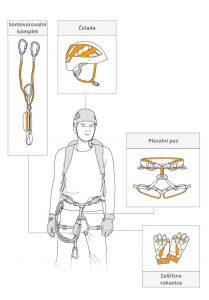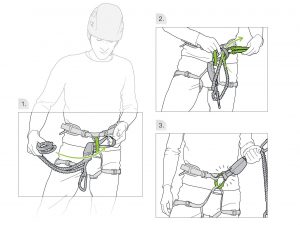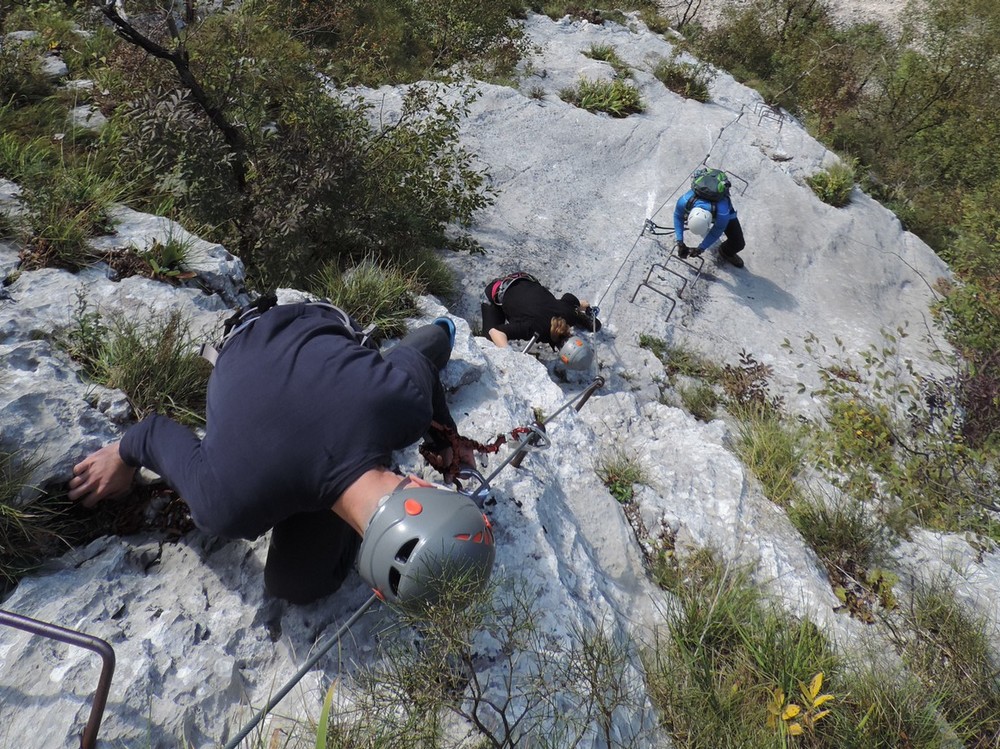CONTENT
In Slovenia, due to the similar equipment used, we often confuse protected climbing routes with very demanding mountaineering trails. Although they may be similarly equipped, they are not the same. A number of Slovenia’s very demanding mountaineering trails are only protected in certain sections (e.g., on Škrlatica, Kočna, Konj).
Modern, sporty Via Ferratas are designed for sports enjoyment and adrenaline and are generally shorter, with difficulties distributed throughout the entire route.
Very demanding mountaineering trails (Hanzova pot on Velika Mojstrovka, Kopiščarjeva pot on Prisojnik, all trails to the summit of Triglav, the path through Turski žleb, etc.) lead to peaks, are very long, and require a considerable amount of general mountaineering skills. Especially in spring and early summer, they may still hold snow, and the descents are long and often technically challenging.
Demanding/very demanding mountaineering trails can have longer sections which are not protected with a steel wire. Some of these trails in Slovenia are equipped only with pegs and have no steel wires whatsoever! They follow natural passages and ledges which can hold snow late into the summer. Via Ferrata, on the other hand, are usually equipped (protected) with a steel wire from start to finish, without any interruptions. Their lines are also more direct, steeper, and more exposed.
DIFFICULTY AND GRADING
Various scales are used to grade the technical difficulty of Via Ferratas. Protected mountaineering trails are also graded using different scales, but they are very comparable. Most of Slovenia’s Via Ferratas are graded using the Austrian grading system.

The general rating indicates the difficulty of the hardest section, with verbal or graphical descriptions providing ratings of individual sections. Raw strength is useful, but long and challenging Via Ferratas also require planning, experience and overall fitness. It is best to progress gradually, so it is advisable to go for a short and easy route for your first Via Ferrata experience. This way, you’ll be able to enjoy the experience and look forward to further climbs.
Before climbing a Via Ferrata, it is wise to learn about as many details as possible: required equipment, difficulty, emergency exit options, descent. Not all Via Ferratas are constructed and equipped to the same quality standards. So be wary of online "experts" who claim everything is "easy".
BEFORE THE CLIMB
Via Ferratas can be dangerous, so make sure to climb your first one in the company of a right person. If you don’t know anyone with the required skills and experience, hire a mountain guide.
As with all mountain itineraries, the preparation starts at home. Check the technical and physical difficulty (general and by sections), explore the so-called emergency exits (which allow you to get off the Via Ferrata if you get too tired to continue or encounter an overly challenging section), and learn about the approach and descent paths.

Via Ferratas can be highly complex itineraries with long approach, climbing, and descent times, which can be even longer if fear is involved, which can turn a one-hour ascent into an all-day tour. So don’t forget to pack a headlamp with fully-charged batteries.
PERSONAL AND TECHNICAL EQUIPMENT
The basic equipment for Via Ferratas consists of the following items:

Source: Petzl/Progression basics for via ferrata
A helmet protects the head from falling rock, impacts during falls, and collisions with obstacles above us. It protects the skull from fractures by dissipating the impact energy across the entire surface, thus absorbing and reducing the blow.
To optimally perform this function, it must be properly fitted. It is secured to the head with straps and adjusted to the correct size so it cannot be pushed forward, backward, left, or right. It shouldn’t be too tight, though, as this could cause discomfort and impede blood circulation.
Helmets should be well ventilated and a mounting point for a headlamp and protective goggles is also welcome.


Source: PZS/Matjaž Šerkezi
Only undamaged, factory-made, and not too old helmets with UIAA or CE certification provide adequate protection. Bike and work helmets are NOT suitable for mountaineering!
The climbing harness should be comfortable enough not to obstruct our movement. The belay loop of the harness should be above the body’s center of gravity, which is located just below the navel. Full-body harnesses or two-piece harnesses with chest straps are the preferable option for small children, pregnant women, and people with large bellies.
You can check if a harness suits you by doing deep body bends, walking in it at various speeds, doing short jumps, and hanging in it for a few minutes. This will help determine if it feels comfortable or perhaps pinches you anywhere.
Only undamaged, factory-made, and not too old harnesses with UIAA or CE certification ensure adequate safety.
A Via Ferrata set enables safer, dynamic stopping in case of falls on protected routes/paths. For the last two decades, we’ve been using the so-called Y system with a sewn tape in a pouch, which tears in case of a fall, thereby reducing the force on the body.
It consists of a pouch with a belay mechanism (tape or plate), two lanyards, two locking carabiners, and a connecting loop. The loop is used to attach the Via Ferrata set to the harness, and the carabiners are used to attach yourself to the steel wire.

Proper attachment of the Via Ferrata set to the climbing harness. Source: Petzl/Progression basics for via ferrata
When buying/renting a Via Ferrata set, pay attention to the weight rating at which the shock absorber is activated.
Activated Via Ferrata sets should be discarded, as falls cause irreversible damage!
Do not make or assemble a Via Ferrata set yourself! Only undamaged, factory-made, and not too old Via Ferrata sets with UIAA or CE certification ensure adequate safety and a dynamic fall arrest.
Gloves designed for moving along wires are made of elastic materials. They should fit the hand and have a reinforced palm. They can have full or half fingers. They protect against potential palm injuries caused by wires and other causes.
An additional lanyard can be made from a locking carabiner and a short sling (60 cm). It is tied into the belay loop of the harness using a lark’s head knot and is used for hanging while resting or waiting. The lanyards of Via Ferrata sets are too dynamic and stretch too much, even to the point where the wire can no longer be reached.
Some Via Ferrata sets come with an additional lanyard factory installed. Before using such a Via Ferrata set, you must read the manufacturer’s instructions for use.
IDEAS FOR FIRST CLIMBS
In Slovenia, there are several easier Via Ferratas and/or very demanding mountaineering trails that are suitable for your first independent steps into the world of Via Ferrata. Each of them is specific and has its own character, which, as already mentioned, should be studied at home. Here are some suggestions for your first Via Ferrata experience:- Hvadnik Via Ferrata above Gozd Martuljek will cool and refresh you in the heat of the summer. It runs along the stream of the same name, so it requires extra caution, especially due to wet rocks.
- Aljaževa pot is one of the two Via Ferratas above the Slovenian Alpine Museum in Mojstrana. You can rent equipment at the museum and visit the interesting exhibitions about Slovenia’s rich mountaineering history.
- Family Via Ferrata on Kanin leads to Prestreljeniško okno (a natural window) and offers wonderful views of the Julian Alps. We recommend using the cable car as the path from the valley is very long.
- Furlanova pot on Gradiška tura is one of the oldest routes of its kind in Slovenia. It can get very hot, so don’t attempt it during warm summer months. There’s also the much more difficult Otmarjeva pot nearby. Be careful to follow the correct signs on the approach!
- Pogačnikova pot can easily be found on the walls under Šmarna gora near Ljubljana. This short, somewhat more difficult, but excellently protected trail offers wonderful, varied, and scenic climbing above the Sava River. Don’t be fooled by the many passersby who have no equipment whatsoever – the route is not as easy as it first seems.
- Path through Hudičev graben under Grmada pri Celju runs through a gorge with a stream, above which there is a cleverly and interestingly laid out mountaineering trail with a steel wire and pegs. An interesting introduction to the Via Ferrata life, although it can’t be considered a true Via Ferrata.
- The top of Lisca can be reached via a nice Via Ferrata. It is characterized by numerous emergency exits, making it a great choice for your first foray into such protected climbing routes. The most difficult part is at the very end, but it can be easily bypassed to conclude the tour with refreshments at the Tončkov dom na Lisci mountain hut.
Having experienced company is crucial for your first Via Ferrata experience. A friend who’s just returned from a course is not the best option. It is better to go with someone who is accustomed to climbing Via Ferratas, knows the equipment, and is familiar with all the techniques.

